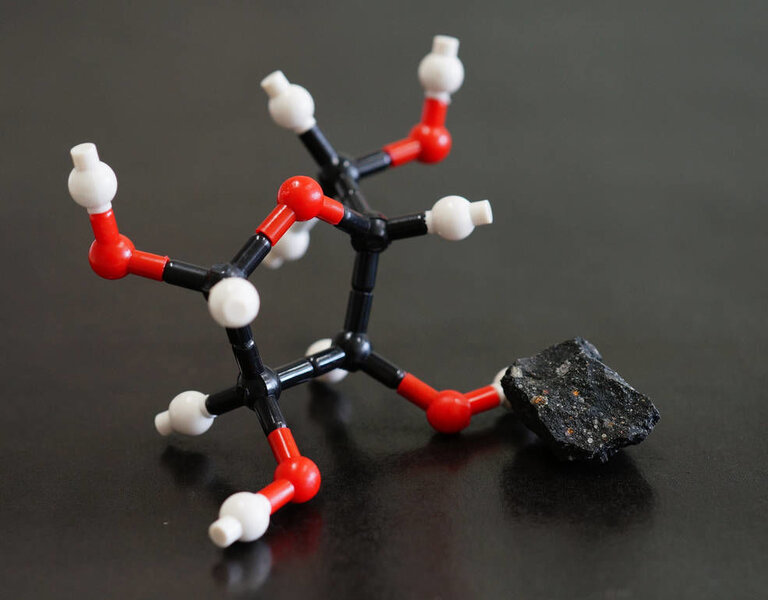Create a free profile to get unlimited access to exclusive videos, sweepstakes, and more!
Sweet! Sugars found in meteorites for the first time

If you had to list the very basic elemental ingredients for life on Earth, you'd have to include carbon, hydrogen, oxygen, and nitrogen (collectively called CHON) as your main ones, plus a smattering of others like phosphorous, sodium, and iron. If you took a step up in complexity and included molecules, then you'd also want things like amino acids (the building blocks of proteins), nucleobases (the building blocks of nucleic acids like RNA and DNA), and sugars.
A lot of these chemicals are pretty simple, and form easily in the right conditions. Conditions on early Earth may have been conducive to construct them, but it may surprise you to find out things were pretty good in space, too. The very first solid bits of material to form in the disk of gas and dust swirling around the proto-Sun 4.6 billion years ago were rich in carbon and those other ingredients, even the complex ones.
And many of them have actually been found in meteorites! Amino acids, nucleobases, and other relatively complex molecules have been found in rocks that fell from space, ones that had been orbiting the Sun for tall those eons since they formed. Weirdly, though, one of the major ingredients has historically not been found: sugars, specifically the kind life is based on.
However, scientists have just announced they have, for the first time, detected biological sugars in meteorites! This includes ribose, arabinose, xylose, and lyxose. Ribose is particularly important, because it's a key part of RNA — ribonucleic acid — which is critical in the formation of life on Earth. It's what's called a macromolecule (a very large and usually complex molecule) that can store a vast amount of information, and is used as a basis of a lot of biological processes. Life on Earth was probably based on RNA first, and then later was replaced by DNA (deoxyribonucleic acid). We still use RNA in our cells for a lot of functions.
The researchers looked at three different meteorites: NWA 801, NWA 7020, and the famous Murchison meteorite. All three are what are called carbonaceous chondrites, which are a group of "primitive" meteorites, meaning they formed very early in the history of the solar system and remain relatively unchanged since that time. In that sense they're like time capsules from over 4.5 billion years ago!
Sugars have been found in meteorites like these before, but there has always been a problem with knowing if the sugars are native to the meteorites, or leeched into the meteorites as they sat on Earth, contaminating them. The researchers in this new work used a new technique that extracts sugars more reliably. Also, they were able to show that the sugars in the meteorites were much less likely to come from Earth, by looking at the isotopes of carbon in them.
Carbon is defined as an atom with 6 protons in its nucleus. If it has six neutrons there as well we call it 12C. That's by far the most common form of carbon on Earth, and the kind preferentially used in biological processes here. But there's a different kind with 7 neutrons, called 13C, and that's common in space. The sugars in the meteorites were enriched in 13C over the amount you'd expect to find from sugars on Earth, which supports the idea that they are indeed from space.
In those very early times in the solar system, grains of material condensed out of the solar nebula first, then collided with each other and grew. Eventually larger asteroids formed, and this complicated things since these had of water in them that could change the chemistry going on. The researchers here looked at the mineral structures of the meteorites and found evidence that some of the sugars could have formed early on, when the grains were very small, and some may have formed later, when the grains were in larger asteroids, where water was present. Even before the planets themselves formed, these sugars were coming together.
One thing they didn't find in the meteorites was deoxyribose (similar to ribose, but with an OH molecule replaced by a hydrogen atom in the structure). It's long been thought that meteorites like these supplied Earth with many of the basic chemicals needed for life. While the sample here is small the lack of deoxyribose is interesting. Extrapolating from this, it means that ribose could have been supplied much more than deoxyribose. There's an idea called "RNA world", which posits that early life on Earth was based on RNA, before DNA came about. The presence of ribose in the meteorites and lack of deoxyribose supports this idea, though of course doesn't confirm it. A lot of steps are still missing, but this is interesting.
The point is that scientists are still trying to figure this out, and while a picture is emerging, a lot of the pieces are still missing. Sugars are a big part of this, so this new research is a lovely step forward in filling in those gaps.
How did life start on Earth? We don't know, but perhaps someday soon we will.




























